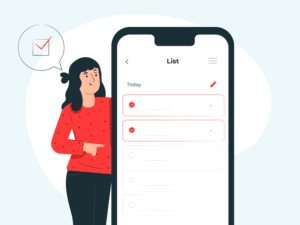The sale is just the beginning. Yes, it feels good to get the win, but the lifetime value of any customer is what’s most important. Studies show that even a 5% increase in retention can boost profits by 25% to 95%. In fact, an incredible 61% of small businesses’ revenue comes from repeat customers.
While you should always make efforts to win new business, this should never come at the expense of your current ones. That means you need to focus on keeping your customers happy.
And that begins from day one after the sale.
After-sales service

Just because they’ve said “yes,” doesn’t mean your work is over. The positive moment of the initial conversion needs to be immediately built upon to ensure that it evolves into a productive relationship.
The way to do this is with something called “after-sales service.” It is, exactly as it sounds, a series of predetermined steps and best practices that ensure the customer is receiving the service they expect at every point.
But what does after-sales service actually involve? Well, the answer is quite a lot. It’s a mixture of proactive messaging, soliciting feedback, dealing promptly with any issues, and ensuring customers are properly trained to get the most out of your product.
As for who carries it out, that’s also got a lot of different potential answers. Some of it will definitely be the role of the after-care team, which is usually also the sales team. Of course, depending on what the issue is, the manufacturer or developer of the product may need to get involved.
But much of it won’t even require an actual individual to be present at all. Whether onboarding, checking up, or any other predictable, repeatable part of after-sales care, your CRM platform with automation capabilities will be able to alleviate a lot of your team’s work.
However you choose to implement it, there’s no denying that it’s essential to your ongoing success. A study carried out by Microsoft found that an incredible 95% of customers cite the service they receive as a key factor in brand loyalty.
What your after-sales service should include

Know you want to start offering after-sales care but not sure where to start? Below, we’ll outline some of the key points in the journey, beginning just after the sale, to ensure you begin the new relationship with your best foot forward.
Onboarding emails
This may sound simple, but a “thank you” and “welcome” go a long way. As soon as the sale goes through, you should send a welcome email.
But that’s not all that’s involved in onboarding. Of course this depends on the nature of your product, but if it’s more complex, you’ll need to educate your customers on how to use it.
As a rule of thumb, we would recommend your onboarding sequence is made up of:
- One welcome email to the specific service they’ve signed up for.
- Four or five emails dealing with specific areas, sent out in the first week or two.
- Three feedback emails. The first after two weeks, the second after a month, and the third after three months.
Nurturing emails
As we said, your current customers are your best source of new business. That means you should continue to nurture them even after they’ve been converted. While these emails can be quite direct and to the point, you need to make sure any cross-sell or upsell opportunities you present can genuinely add value to your customer. You can’t just sell for the sake of selling.
Your onboarding sequence will likely include some nurturing emails, but it’s a good idea to develop separate campaigns for this. Just make sure not to overdo it. Emails are welcome and helpful, but too many can be frustrating.
AI Chatbots and FAQs
Help your customers to help themselves. Not every issue they have will require a specialist on hand to answer their questions. Sometimes, keeping your customers happy means empowering them to solve their own problems. That’s where a robust FAQ database and a chatbot come in handy. Not only do these help ease the strain on your customer service team, but it also speeds up the process for customers.
An internal ticketing system
Organization is essential to provide a solid customer service that is seamless and responsive. Within your CRM, you should have the ability to not only see every interaction you have with your customers, but you should also be able to record and store their requests. For this, you will need a built-in ticketing system that allows you to assign urgency levels and reps to resolve issues.
Resources for training

For more complex products or services, your customer might need proper training to be able to get the most out of it. The onboarding process should cover the basics but after the initial setup, your customer will likely need additional training to get the most out of it. For this reason, it is important to provide the option for training, either for free or as a cross-sell.
In the same vein, you can consider hosting expert-led webinars or similar content-sharing initiatives. Although these are more marketing activities, they can have value for current customers if done well!
Give them rewards!
Your customers are the backbone of your business and you shouldn’t take them for granted. If they meet certain criteria, whether high spenders or long-time customers, reach out to them and offer a reward. While you can use this as an incentive for further cross-selling opportunities, sometimes it’s nice to give them something without anything in return. It is a fantastic way to strengthen loyalty and ensure long-term revenue.
Warranties, replacements and returns
Depending on the type of product you have, you should put into place some sort of policy for instances where the customer is severely and justifiably unhappy. Even the best businesses in the world can sometimes be faced with quality issues, but it’s how you respond to them that can turn the customer into a detractor or keep them as a loyal promoter.
That said, you shouldn’t authorize your after-sales team to give free products or discounts to anyone who makes a complaint. Instead, you should develop criteria to ensure they fulfill certain terms and conditions.
Feedback, feedback, feedback
You should always be looking for feedback at every stage. We recommend including this in the onboarding sequence, but you can also try to solicit it in other ways. Implementing popups with star ratings or NPS scales in strategic locations or asking for reviews on popular platforms are other ways to get more feedback. More importantly, it’s not just about getting the feedback, you also need to listen to the insights and apply as necessary to ensure the ongoing satisfaction of your customers.
Developing a robust after-sales service is one of the best ways to ensure long-term value from your customers. By ensuring they are happy, not only are they likely to spend more money over a long period of time, but they are also more likely to refer your services to those they come into contact with.
If you’d like to find out more about the role Pipeline.so plays in keeping your customers happy by automating and streamlining your after-sales service, reach out to us today!

